THE BOWMAKER'S NIGHTMARE: THE TREACHEROUS WOOD
Pernambuco is a wonderful wood ! Tense and nervous, compact and carnal, full of colors ranging from amber yellow to black throughout a rainbow of endless shades. Its longitudinal fiber is incredibly straight and it interweaves with the long and even medullary rays,, making it look like a real fabric full of light, woven on a loom. A beautiful Pernambuco, is as a beautiful woman, but like women, the nicer you are, the more unpredictable you become ! "Ca va sans dire" as, in fact, a Frenchman would say.
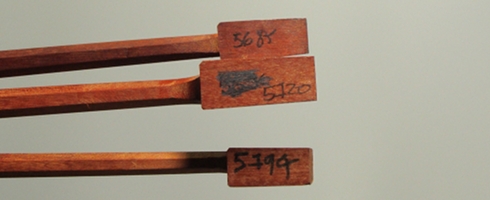
I do not know if I have ever said to you that the percentage of wood fit to make bows, among all the existing pernambuco is 0.05%. As you know, nowadays, the wood for bows is selected using the sound speed as fundamental parameter. In Italy, for example, bowmakers begin to buy wood starting from the speed of 5500 m / s, they build between 5600 and 5700 their normal level, between 5800 and 5900 the absolute level, over 5900 or up to 6000 and more (even if slightly more) if all the 'ifs', are positively solved, a miraculous level can be reached. .
The good building material is rare and even the percentages are important: the sticks above 5700 are about 25-30, among a selection of 100 from 0.05% of the total, in my career I saw only three of them above 6000 m / s, one of which unusable. The highest of course a 6167 (Sigh!).
Of course these numbers are to be considered in a perfect world inhabited by good wizards and blue fairies, because obviously the wood, like everything else, is subject to various kinds of diseases and injuries, that furtherly reduce the percentage of usable material. Furthermore, as in the case of the three sticks of the picture, you will realize that they can be thrown away only after two weeks spent working them. The defects are not always easily visible when the wood is raw and to detect them you need to break your back using the plane.
The most common flaws that may be hidden before the working process are mainly three:
1) Knots
2) Longitudinal openings
3) Cancers
Let's go on with order and analyze them one by one.
Knots
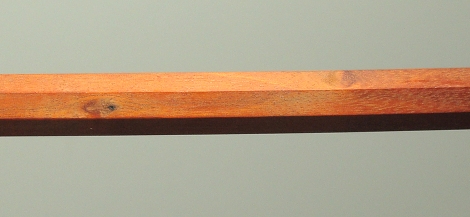
Knots are common in every type of tree as a knot is the birth of a new branch. Even if this defect may scary many musicians, its presence is almost never a disabling one. For example, in the stick of the photo, there are two knots, one on the right side that is pretty large and a tighter one on the left side. With just the first one, this beautiful cello stick, speed 5720 m / s, would have become an excellent bow, mainly because it is very broad and touches it only tangentially. But there is also the second one, narrower and treacherous, crossing the stick from side to side. Even the second knot probably would never open up, but we didn't dare to risk so we quit.
Longitudinal openings
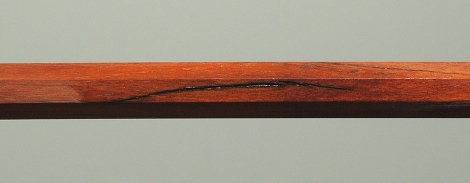
This problem may appear already during the first polishing , but it becomes evident in particular during the first bent. The bowmaker, by heating and then bending the wood , definitely opens up the crack that was already in . The causes of such breakage may be different. A weather event as a strong wind, or the sudden change of moisture, much higher in Brazil than in Europe, weaken the wood structure so that is often yields while processed. I say "often" , because sometimes it happens that the microfracture is inside the stick therefore cannot be detected from the outside. The bowmaker , who is not equipped with X-ray vision, does not see it, and one day, the bows poof opens up in the hands of the user. Personally I have seen it happening !
Cancers
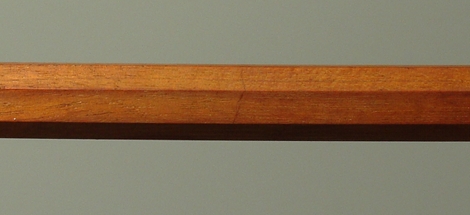
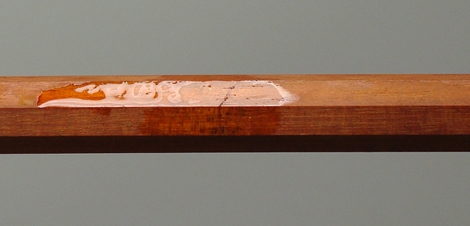
This is the real subtle and unpredictable scourge for every bowmaker. Cancer is a real break across the fiber, and it is usually caused by a strong wind . The extremely tense fibers of the tree break under the pressure of the wind, and when it ceases, they may reposition in the same place so that they are difficult to detect. In the pictures they can clearly be seen because I highlighted them by spraying them with alcohol. Unfortunately, this type of damage owns a terrible but appropriate name. We rarely escapes from this problem, as in the case of the stick in the photo. Cancer runs through it completely from side to side, and in fact this is not a piece of wood, but two, because even if it still stay together , the fiber is not attached. Also this violin stick, 5794 m / s, had unfortunately to be left apart. I will never forget M° Navea Vera's face , and I am sure he will never forget mine, when as happy as children we eagerly watched our 6167 m / s stick , handling it making appraisal comments like "What a beautiful texture" or " Look what a wonderful straight fiber " and "what about cutting... perfect" . We had in our hands "THE " stick and we enjoyed it when seized by an inexplicable anxiety I told M° Navea Vera: "Daniel, put it under the plane as soon as possible, I want to see what's underneath." . Luckily, at least this time there was no need to process it . As soon as I said this sentence, we realized that horrendous line running through it completely, and the dream of any bowmaker suddenly disappeared from our hands.
So long
Paolo
|
 
 |